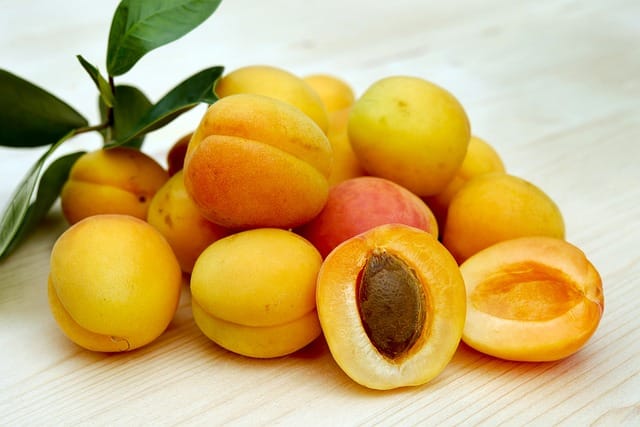How to grow Apricots
Apricots (Prunus armeniaca) are delicious and nutritious fruits that are closely related to peaches and plums

In this article:
- Introduction to Apricots
- Selecting the Right Apricot Varieties
- Climate and Soil Requirements for Apricots
- Choosing the Perfect Location for Apricot Trees
- Preparing the Soil for Apricot Planting
- Propagation Techniques for Apricot Trees
- Planting and Caring for Apricot Trees
- Watering and Fertilizing Apricot Trees
- Pruning and Training Apricot Trees
- Understanding Common Pest and Disease Issues with Apricots
- Harvesting and Storing Apricots
- Tips for Maximizing Apricot Fruit Production
- Creative Uses for Apricots in the Kitchen
- Health Benefits of Apricots
- Frequently Asked Questions about Growing Apricots
Introduction to Apricots
Apricots (Prunus armeniaca) are delicious and nutritious fruits that are closely related to peaches and plums. They are known for their sweet and tangy flavor, and are packed with essential vitamins and minerals. This article will guide you through the process of successfully growing apricot trees and enjoying a bountiful harvest.
Selecting the Right Apricot Varieties
When choosing apricot varieties, it is important to consider your climate, as different varieties thrive in different environments. Some popular apricot varieties include Moorpark, Goldcot, and Goldrich. Research and choose a variety that suits your specific growing conditions.
Climate and Soil Requirements for Apricots
Apricot trees prefer a Mediterranean climate, characterized by long, hot summers and mild winters. They require well-drained soil with a pH level between 6.0 and 7.5. If the soil in your area is not suitable, you can improve it by adding organic matter such as compost or well-rotted manure.
Choosing the Perfect Location for Apricot Trees
Apricot trees need a sunny location that receives at least 6-8 hours of direct sunlight per day. They should also be protected from strong winds, as gusty winds can damage the delicate branches and blossoms. Choose a location with good air circulation to prevent diseases.
Preparing the Soil for Apricot Planting
Prior to planting, prepare the soil by removing any weeds, rocks, or debris. Loosen the soil using a garden fork or tiller to improve aeration and drainage. Incorporate organic matter to increase fertility and moisture retention. Consider conducting a soil test to determine if any amendments are needed.
Propagation Techniques for Apricot Trees
Apricot trees can be propagated through seeds or by grafting onto a rootstock. Growing apricots from seeds is relatively easy but may result in variations in fruit quality. Grafting, on the other hand, allows for the propagation of desired characteristics and is the preferred method for commercial apricot cultivation.
Planting and Caring for Apricot Trees
Prepare a planting hole that is twice the size of the tree's root ball. Place the tree in the hole, ensuring that the bud union is above the soil line. Backfill the hole and gently firm the soil around the tree. Water thoroughly after planting and provide proper care, including regular watering, mulching, and weed control.
Watering and Fertilizing Apricot Trees
Apricot trees require regular watering, especially during hot and dry periods. The soil should be kept moist but not waterlogged to avoid root rot. Fertilize apricot trees annually, preferably in early spring, using a balanced organic fertilizer. Avoid over-fertilization, as it can harm the tree.
Pruning and Training Apricot Trees
Pruning is essential for apricot trees to ensure proper shape, improve airflow, and increase fruit production. Prune during late winter or early spring, removing dead, damaged, or diseased branches. Train the tree to an open center or modified central leader system to allow sunlight to penetrate the canopy.
Understanding Common Pest and Disease Issues with Apricots
Apricot trees can be susceptible to pests such as aphids, mites, and codling moths. Regular monitoring and early intervention can prevent serious infestations. Common diseases that affect apricot trees include brown rot, peach leaf curl, and bacterial canker. Proper sanitation, regular spraying, and disease-resistant varieties can help minimize these issues.
Harvesting and Storing Apricots
Apricots are ready to be harvested when they are firm, fully colored, and easily separate from the tree. Pick the fruits gently to avoid bruising. After harvest, store them in a cool, dry place or refrigerate for a few days to extend their shelf life. Do not wash them until you are ready to consume them.
Tips for Maximizing Apricot Fruit Production
To maximize fruit production, consider cross-pollinating apricot trees with another compatible variety. Remove excess fruit when they are small to prevent overcrowding. Apply thinning techniques to improve fruit size and quality. Provide proper care throughout the year, including regular irrigation, pest control, and mulching.
Creative Uses for Apricots in the Kitchen
Apricots are not only delicious when eaten fresh, but they can also be used in various culinary applications. They can be dried, canned, or used in jams, jellies, salads, desserts, and savory dishes. Explore different recipes to showcase the versatility and unique flavor of apricots in your kitchen.
Health Benefits of Apricots
Apricots are a nutrient-dense fruit that offer numerous health benefits. They are rich in vitamins A and C, fiber, antioxidants, and minerals such as potassium and iron. Including apricots in your diet can support eye health, boost the immune system, aid digestion, and contribute to overall well-being.
Frequently Asked Questions about Growing Apricots
Q: How long does it take for an apricot tree to produce fruit?
A: Apricot trees typically take 2-4 years to start bearing fruit after planting.
Q: Can I grow apricots in containers?
A: Yes, it is possible to grow dwarf apricot varieties in containers, provided they receive adequate sunlight and care.
Q: How often should I prune my apricot tree?
A: Apricot trees should be pruned annually during late winter or early spring.
Follow these guidelines and enjoy the satisfaction of growing your own apricots. With proper care and attention, you can enjoy a bountiful harvest of these tasty fruits year after year.
